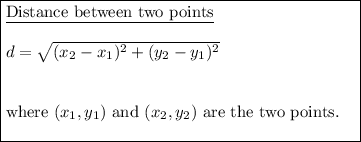Answer:
11. Perimeter: 17.7 units
11. Area: 14 square units
12. Perimeter: 24.7 units
12. Area: 34 square units
Explanation:
Question 11
Given vertices of the polygon:
- A = (-2, 1)
- B = (2, 5)
- C = (5, 1)
Plot the given points in the coordinate plane (see attachment 1).
From inspection, we can see that the polygon is a triangle with the following dimensions:
- Base = 7 units
- Height = 4 units

The length of AC is 7 units.
To find the length of AB and BC, use the distance formula.


Therefore:


Question 12
Given vertices of the polygon:
- A = (-3, 5)
- B = (1, 6)
- C = (3, -2)
- D = (-1, -3)
Plot the given points in the coordinate plane (see attachment 2).
From inspection, we can see that the polygon is a rectangle.

Since AB = DC and BC = AD, find the length of AB and BC using the distance formula.


Therefore:

